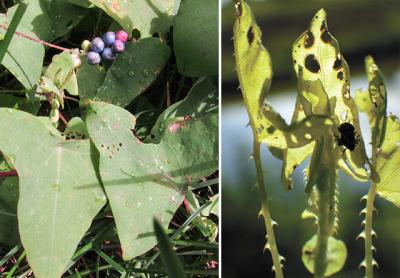Star Gardener: A Nightmare Infestation

Mile-a-minute vine has established a foothold in East Hampton. It grows six inches a day and 20 feet in one season, can smother and kill anything in its wake, and can even cover phragmites, itself a rapacious invasive weed. Unlike other invasive plants, it would be fairly easy to contain or eliminate manually and with biological controls, if only we had the will and organization.
Dr. Andy Senesac, the weed science specialist at Cornell Cooperative Extension in Riverhead, says the problem has become much worse in our area since the devastation from Hurricane Sandy in 2012. Mile-a-minute first arrived in Nassau County back in the late 1990s, after working its way north from its original release at a nursery in southeastern Pennsylvania in the 1950s or early ’60s. By 2005 it was reported on the North Fork.
I had been only dimly aware of it. All it took was two small seedlings germinating in different parts of my own garden to bring it front and center to my consciousness. It’s odd that I knew immediately what they were, although I don’t recall ever seeing a photo.
Subsequently, I’ve seen the vine along the roadside in a wooded area farther out in Springs and in one or two other gardens. More alarming, it is becoming established in areas on Hook Pond, and two weeks ago I saw a nightmare infestation in a sunny open area on Buckskill Road across from Dune Alpin. That’s what made me phone Dr. Senesac to learn how bad it is on the East End and what, if anything, can be done to eradicate it.
Mile-a-minute is an annual vine native to Japan and China, Southeast Asia and India. It has light-green triangular leaves growing on narrow pink stems with recurved barbs that account for its other common name, Devil’s-tail tearthumb. It invades and becomes established in a wide variety of habitats, open and disturbed areas like fields, wetlands, forest edges, and roadsides. Unfortunately, deer do not touch mile-a-minute vine, eating native plants instead. That encourages mile-a-minute to become superdominant, Dr. Senesac says.
It germinates here in early April and has weak roots, making it easy to pull. Because of the shape of the prickles, the young vines grow straight upright. He recommends manually pulling young vines in May and June, but cautions to wear long sleeves and gloves; the prickles can break in the skin and are difficult to remove. Early in the season, vines can be left where they’ve been pulled, put on the compost pile, or taken to the dump.
By mid-August the fruit begins to ripen and turn bright blue. The ripe fruit falls off the vines easily and scatters widely, so from then on it’s not good to remove it. Mark the spot and return in May to clear the area.
Seeds can remain viable in the soil for up to five years. They can be spread over long distances by birds. Water, too, is an important way the vine spreads, as its fruit remains buoyant for seven to nine days, according to the State Department of Environmental Conservation.
An entomologist from the University of Delaware went to China in the early 2000s and found about 100 different insects feeding on mile-a-minute vine, keeping it in check. Of those, a weevil (Rhinoncomimus latipes) has passed tests from the U.S.D.A. and other government agencies in the United States. The adult weevil chews the leaves and lays its eggs on the vine. It takes a while to build up a population that can control the infestations.
A few thousand weevils were released on the North and South Forks before funding ran out. Dr. Senesac continues to monitor those sites and track new infestations. He is hoping for a grant to enable him to purchase and release more.
At this point, home gardeners can easily control the odd vine that lands on their property, and sharp-eyed citizens can pull individual vines from the roadside. Manual pulling isn’t realistic for larger infestations. In some places the D.E.C. and the Nature Conservancy have partnered with local organizations and volunteers to clear areas.
Dr. Senesac told me the rearing lab charges $1 per weevil, with about 250 to 500 needed for an initial release. (They come in a box the size of a small ice cream container.) Reservations are taken beginning in early March. While the best time to release them is May and June, they remain effective until early August. Results wouldn’t be seen until the following year.
Unlike other invasives like knotweed, phragmites, and porcelain berry, controlling mile-a-minute vine is possible, and even easy.
